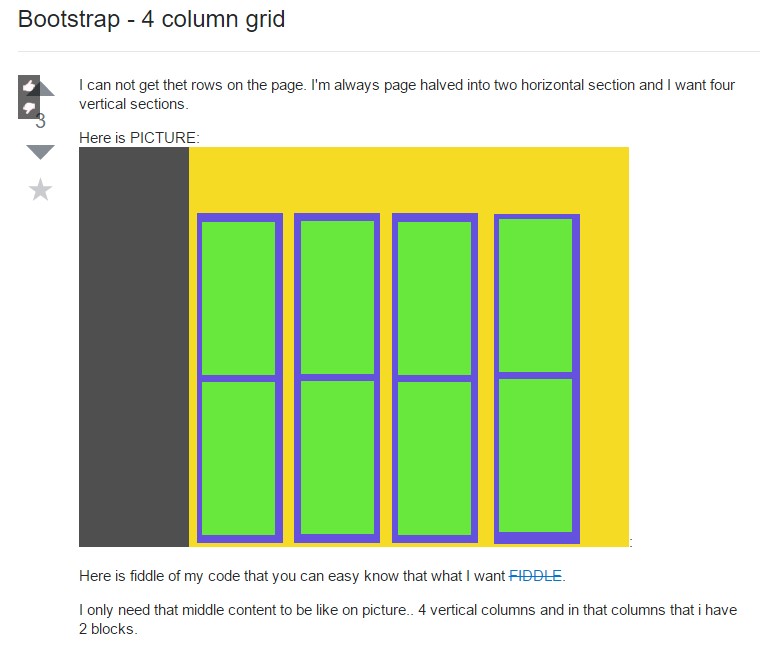Bootstrap Grid System
Introduction
Bootstrap features a strong mobile-first flexbox grid system for creating formats of any scales and looks . It's founded on a 12 column design and provides several tiers, one for each media query range. You are able to use it using Sass mixins or else of the predefined classes.
The absolute most crucial component of the Bootstrap platform helping us to make responsive website page interactively changing to regularly fix the size of the screen they get presented on yet looking amazingly is the so called grid solution. The things it usually does is giving us the opportunity of establishing complex layouts combining row plus a specific number of column components stored within it. Think that the visible width of the display is parted in twelve matching elements vertically.
Exactly how to employ the Bootstrap grid:
Bootstrap Grid CSS applies a number of rows, containers, and columns to format as well as line up content. It's built having flexbox and is fully responsive. Shown below is an example and an in-depth check out how the grid comes together.
The aforementioned situation builds three equal-width columns on little, medium, large, and extra sizable devices working with our predefined grid classes. Those columns are centralized in the webpage together with the parent
.containerHere's how it does the job:
- Containers deliver a method to focus your internet site's items. Employ
.container.container-fluid- Rows are horizontal bunches of columns that ensure your columns are definitely arranged effectively. We employ the negative margin method with regards to
.row- Web content ought to be set in columns, and just columns can be immediate children of rows.
- Thanks to flexbox, grid columns free from a established width is going to immediately format using identical widths. For example, four instances of
.col-sm- Column classes identify the several columns you want to apply removed from the potential 12 per row. { Therefore, in case you need three equal-width columns, you can use
.col-sm-4- Column
widths- Columns come with horizontal
paddingmarginpadding.no-gutters.row- There are five grid tiers, one for each responsive breakpoint: all breakpoints (extra small-sized), little, medium, huge, and extra large.
- Grid tiers are formed on minimum widths, indicating they apply to that tier plus all those above it (e.g.,
.col-sm-4- You have the ability to use predefined grid classes as well as Sass mixins for extra semantic markup.
Recognize the issues as well as problems about flexbox, like the lack of ability to work with certain HTML components such as flex containers.
Sounds good? Outstanding, let us carry on to seeing all that during an example. ( click this)
Bootstrap Grid System possibilities
Basically the column classes are actually something like that
.col- ~ grid size-- two letters ~ - ~ width of the element in columns-- number from 1 to 12 ~.col-Whenever it goes to the Bootstrap Grid HTML sizings-- all of the possible widths of the viewport (or the viewable space on the screen) have been split up to five varieties as comes next:
Extra small-- widths under 544px or 34em ( that comes to be the default measuring unit around Bootstrap 4
.col-xs-*Small – 544px (34em) and over until 768px( 48em )
.col-sm-*Medium – 768px (48em ) and over until 992px ( 62em )
.col-md-*Large – 992px ( 62em ) and over until 1200px ( 75em )
.col-lg-*Extra large-- 1200px (75em) and anything greater than it
.col-xl-*While Bootstrap works with
emrempxObserve the way components of the Bootstrap grid system perform all around various tools having a functional table.
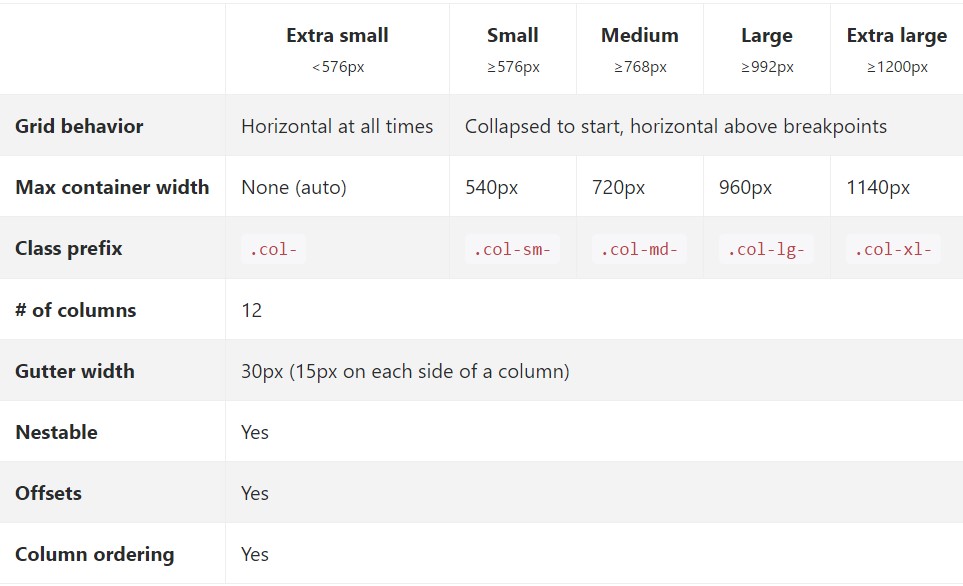
The various and brand new from Bootstrap 3 here is one additional width range-- 34em-- 48em being assigned to the
xsEach of the features designated using a particular viewport width and columns care for its size in width when it comes to this viewport plus all above it. Anytime the width of the display gets under the defined viewport size the components pile over each other stuffing the entire width of the view .
You have the ability to as well appoint an offset to an aspect via a defined amount of columns in a certain display sizing and on top of this is done with the classes
.offset- ~ size ~ - ~ columns ~.offset-lg-3.col- ~ size ~-offset- ~ columns ~A couple things to take into account when constructing the markup-- the grids incorporating rows and columns need to be placed in a
.container.container.container-fluidPrimary kins of the containers are the
.rowAuto style columns
Apply breakpoint-specific column classes for equal-width columns. Include any quantity of unit-less classes for each and every breakpoint you need and each and every column will certainly be the equivalent width.
Equal size
As an example, below are two grid layouts that used on every gadget and viewport, from
xs
<div class="container">
<div class="row">
<div class="col">
1 of 2
</div>
<div class="col">
1 of 2
</div>
</div>
<div class="row">
<div class="col">
1 of 3
</div>
<div class="col">
1 of 3
</div>
<div class="col">
1 of 3
</div>
</div>
</div>Putting one column size
Auto-layout for the flexbox grid columns also signifies you may set up the width of one column and the others will quickly resize about it. You may possibly apply predefined grid classes ( just as presented below), grid mixins, or else inline widths. Take note that the various columns will resize despite the width of the center column.

<div class="container">
<div class="row">
<div class="col">
1 of 3
</div>
<div class="col-6">
2 of 3 (wider)
</div>
<div class="col">
3 of 3
</div>
</div>
<div class="row">
<div class="col">
1 of 3
</div>
<div class="col-5">
2 of 3 (wider)
</div>
<div class="col">
3 of 3
</div>
</div>
</div>Variable size material
Using the
col- breakpoint -auto
<div class="container">
<div class="row justify-content-md-center">
<div class="col col-lg-2">
1 of 3
</div>
<div class="col-12 col-md-auto">
Variable width content
</div>
<div class="col col-lg-2">
3 of 3
</div>
</div>
<div class="row">
<div class="col">
1 of 3
</div>
<div class="col-12 col-md-auto">
Variable width content
</div>
<div class="col col-lg-2">
3 of 3
</div>
</div>
</div>Identical width multi-row
Generate equal-width columns that stretch over multiple rows with adding a
.w-100.w-100
<div class="row">
<div class="col">col</div>
<div class="col">col</div>
<div class="w-100"></div>
<div class="col">col</div>
<div class="col">col</div>
</div>Responsive classes
Bootstrap's grid includes five tiers of predefined classes to get building complex responsive formats. Customise the size of your columns on extra small, small, medium, large, or extra large devices however you see fit.
All of the breakpoints
Intended for grids which are the exact same from the smallest of gadgets to the largest sized, make use of the
.col.col-*.col
<div class="row">
<div class="col">col</div>
<div class="col">col</div>
<div class="col">col</div>
<div class="col">col</div>
</div>
<div class="row">
<div class="col-8">col-8</div>
<div class="col-4">col-4</div>
</div>Stacked to horizontal
Utilizing a individual package of
.col-sm-*
<div class="row">
<div class="col-sm-8">col-sm-8</div>
<div class="col-sm-4">col-sm-4</div>
</div>
<div class="row">
<div class="col-sm">col-sm</div>
<div class="col-sm">col-sm</div>
<div class="col-sm">col-sm</div>
</div>Mix up and match
Really don't prefer your columns to simply stack in a number of grid tiers? Take a mix of different classes for each tier as needed. View the illustration listed here for a better strategy of the way it all acts.

<div class="row">
<div class="col col-md-8">.col .col-md-8</div>
<div class="col-6 col-md-4">.col-6 .col-md-4</div>
</div>
<!-- Columns start at 50% wide on mobile and bump up to 33.3% wide on desktop -->
<div class="row">
<div class="col-6 col-md-4">.col-6 .col-md-4</div>
<div class="col-6 col-md-4">.col-6 .col-md-4</div>
<div class="col-6 col-md-4">.col-6 .col-md-4</div>
</div>
<!-- Columns are always 50% wide, on mobile and desktop -->
<div class="row">
<div class="col-6">.col-6</div>
<div class="col-6">.col-6</div>
</div>Alignment
Work with flexbox alignment utilities to vertically and horizontally line up columns. ( additional info)
Vertical positioning
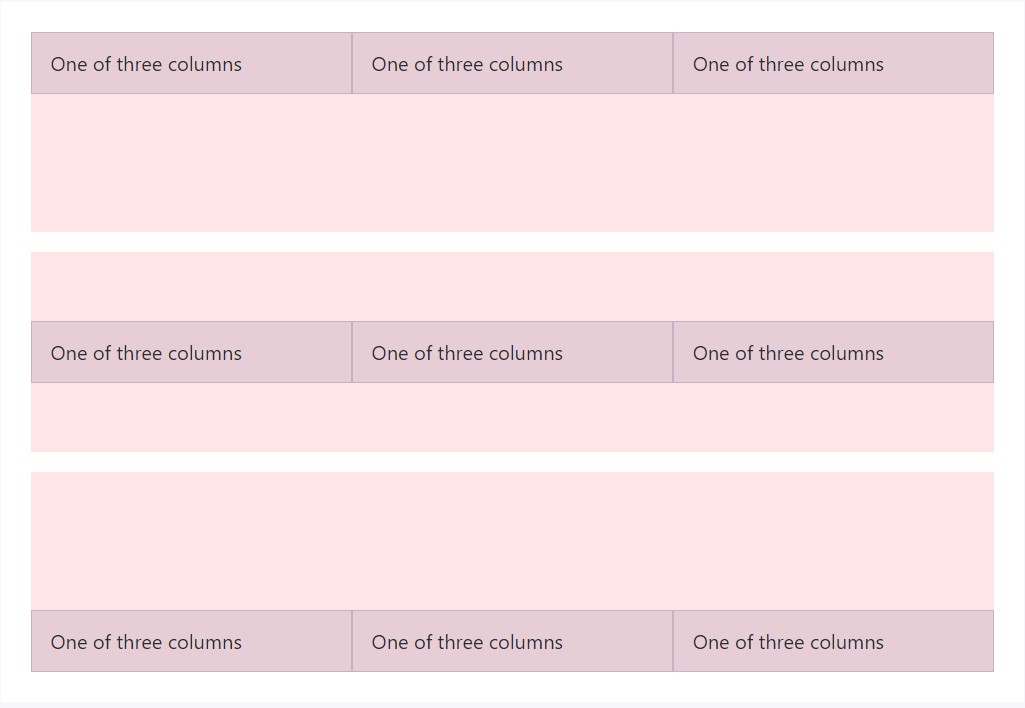
<div class="container">
<div class="row align-items-start">
<div class="col">
One of three columns
</div>
<div class="col">
One of three columns
</div>
<div class="col">
One of three columns
</div>
</div>
<div class="row align-items-center">
<div class="col">
One of three columns
</div>
<div class="col">
One of three columns
</div>
<div class="col">
One of three columns
</div>
</div>
<div class="row align-items-end">
<div class="col">
One of three columns
</div>
<div class="col">
One of three columns
</div>
<div class="col">
One of three columns
</div>
</div>
</div>
<div class="container">
<div class="row">
<div class="col align-self-start">
One of three columns
</div>
<div class="col align-self-center">
One of three columns
</div>
<div class="col align-self-end">
One of three columns
</div>
</div>
</div>Horizontal positioning

<div class="container">
<div class="row justify-content-start">
<div class="col-4">
One of two columns
</div>
<div class="col-4">
One of two columns
</div>
</div>
<div class="row justify-content-center">
<div class="col-4">
One of two columns
</div>
<div class="col-4">
One of two columns
</div>
</div>
<div class="row justify-content-end">
<div class="col-4">
One of two columns
</div>
<div class="col-4">
One of two columns
</div>
</div>
<div class="row justify-content-around">
<div class="col-4">
One of two columns
</div>
<div class="col-4">
One of two columns
</div>
</div>
<div class="row justify-content-between">
<div class="col-4">
One of two columns
</div>
<div class="col-4">
One of two columns
</div>
</div>
</div>No gutters
The gutters within columns inside our predefined grid classes may possibly be taken away with
.no-guttersmargin.rowpaddingHere is simply the origin code for building these kinds of formats. Keep in mind that column overrides are scoped to only the original children columns and are actually intended by means of attribute selector. Although this produces a more specific selector, column padding can still be additional customized together with space utilities.
.no-gutters
margin-right: 0;
margin-left: 0;
> .col,
> [class*="col-"]
padding-right: 0;
padding-left: 0;In practice, here's exactly how it looks like. Take note you can continue to work with this with all of the various other predefined grid classes ( featuring column sizes, responsive tiers, reorders, and much more ).

<div class="row no-gutters">
<div class="col-12 col-sm-6 col-md-8">.col-12 .col-sm-6 .col-md-8</div>
<div class="col-6 col-md-4">.col-6 .col-md-4</div>
</div>Column wrapping
If more than just 12 columns are set inside of a single row, every group of additional columns will, as being one unit, wrap onto a new line.

<div class="row">
<div class="col-9">.col-9</div>
<div class="col-4">.col-4<br>Since 9 + 4 = 13 > 12, this 4-column-wide div gets wrapped onto a new line as one contiguous unit.</div>
<div class="col-6">.col-6<br>Subsequent columns continue along the new line.</div>
</div>Reseting of the columns
Having the handful of grid tiers obtainable, you're expecteded to face difficulties where, at certain breakpoints, your columns really don't clear quite suitable being one is taller compared to the another. To fix that, employ a combination of a
.clearfix
<div class="row">
<div class="col-6 col-sm-3">.col-6 .col-sm-3</div>
<div class="col-6 col-sm-3">.col-6 .col-sm-3</div>
<!-- Add the extra clearfix for only the required viewport -->
<div class="clearfix hidden-sm-up"></div>
<div class="col-6 col-sm-3">.col-6 .col-sm-3</div>
<div class="col-6 col-sm-3">.col-6 .col-sm-3</div>
</div>Besides column cleaning at responsive breakpoints, you may possibly will need to reset offsets, pushes, and pulls. Discover this at work in the grid scenario.

<div class="row">
<div class="col-sm-5 col-md-6">.col-sm-5 .col-md-6</div>
<div class="col-sm-5 offset-sm-2 col-md-6 offset-md-0">.col-sm-5 .offset-sm-2 .col-md-6 .offset-md-0</div>
</div>
<div class="row">
<div class="col-sm-6 col-md-5 col-lg-6">.col.col-sm-6.col-md-5.col-lg-6</div>
<div class="col-sm-6 col-md-5 offset-md-2 col-lg-6 offset-lg-0">.col-sm-6 .col-md-5 .offset-md-2 .col-lg-6 .offset-lg-0</div>
</div>Re-ordering
Flex order
Apply flexbox utilities for managing the vision disposition of your web content.

<div class="container">
<div class="row">
<div class="col flex-unordered">
First, but unordered
</div>
<div class="col flex-last">
Second, but last
</div>
<div class="col flex-first">
Third, but first
</div>
</div>
</div>Neutralizing columns
Shift columns to the right employing
.offset-md-**.offset-md-4.col-md-4
<div class="row">
<div class="col-md-4">.col-md-4</div>
<div class="col-md-4 offset-md-4">.col-md-4 .offset-md-4</div>
</div>
<div class="row">
<div class="col-md-3 offset-md-3">.col-md-3 .offset-md-3</div>
<div class="col-md-3 offset-md-3">.col-md-3 .offset-md-3</div>
</div>
<div class="row">
<div class="col-md-6 offset-md-3">.col-md-6 .offset-md-3</div>
</div>Pull and push
Efficiently switch the structure of our inbuilt grid columns along with
.push-md-*.pull-md-*
<div class="row">
<div class="col-md-9 push-md-3">.col-md-9 .push-md-3</div>
<div class="col-md-3 pull-md-9">.col-md-3 .pull-md-9</div>
</div>Content placing
To home your material along with the default grid, add a brand new
.row.col-sm-*.col-sm-*
<div class="row">
<div class="col-sm-9">
Level 1: .col-sm-9
<div class="row">
<div class="col-8 col-sm-6">
Level 2: .col-8 .col-sm-6
</div>
<div class="col-4 col-sm-6">
Level 2: .col-4 .col-sm-6
</div>
</div>
</div>
</div>Employing Bootstrap's origin Sass data
Whenever putting to use Bootstrap's origin Sass data, you have the possibility of employing Sass mixins and variables to make custom-made, semantic, and responsive page layouts. Our predefined grid classes utilize these same variables and mixins to provide a whole collection of ready-to-use classes for quick responsive arrangements .
Opportunities
Maps and variables determine the amount of columns, the gutter size, and the media query point. We apply these to bring in the predefined grid classes reported just above, as well as for the custom-made mixins listed below.
$grid-columns: 12;
$grid-gutter-width-base: 30px;
$grid-gutter-widths: (
xs: $grid-gutter-width-base, // 30px
sm: $grid-gutter-width-base, // 30px
md: $grid-gutter-width-base, // 30px
lg: $grid-gutter-width-base, // 30px
xl: $grid-gutter-width-base // 30px
)
$grid-breakpoints: (
// Extra small screen / phone
xs: 0,
// Small screen / phone
sm: 576px,
// Medium screen / tablet
md: 768px,
// Large screen / desktop
lg: 992px,
// Extra large screen / wide desktop
xl: 1200px
);
$container-max-widths: (
sm: 540px,
md: 720px,
lg: 960px,
xl: 1140px
);Mixins
Mixins are applied together with the grid variables to provide semantic CSS for specific grid columns.
@mixin make-row($gutters: $grid-gutter-widths)
display: flex;
flex-wrap: wrap;
@each $breakpoint in map-keys($gutters)
@include media-breakpoint-up($breakpoint)
$gutter: map-get($gutters, $breakpoint);
margin-right: ($gutter / -2);
margin-left: ($gutter / -2);
// Make the element grid-ready (applying everything but the width)
@mixin make-col-ready($gutters: $grid-gutter-widths)
position: relative;
// Prevent columns from becoming too narrow when at smaller grid tiers by
// always setting `width: 100%;`. This works because we use `flex` values
// later on to override this initial width.
width: 100%;
min-height: 1px; // Prevent collapsing
@each $breakpoint in map-keys($gutters)
@include media-breakpoint-up($breakpoint)
$gutter: map-get($gutters, $breakpoint);
padding-right: ($gutter / 2);
padding-left: ($gutter / 2);
@mixin make-col($size, $columns: $grid-columns)
flex: 0 0 percentage($size / $columns);
width: percentage($size / $columns);
// Add a `max-width` to ensure content within each column does not blow out
// the width of the column. Applies to IE10+ and Firefox. Chrome and Safari
// do not appear to require this.
max-width: percentage($size / $columns);
// Get fancy by offsetting, or changing the sort order
@mixin make-col-offset($size, $columns: $grid-columns)
margin-left: percentage($size / $columns);
@mixin make-col-push($size, $columns: $grid-columns)
left: if($size > 0, percentage($size / $columns), auto);
@mixin make-col-pull($size, $columns: $grid-columns)
right: if($size > 0, percentage($size / $columns), auto);An example utilization
You can certainly reshape the variables to your personal customized values, or else just utilize the mixins having their default values. Here is literally an example of taking the default settings to build a two-column format having a divide among.
View it practical within this delivered good example.
.container
max-width: 60em;
@include make-container();
.row
@include make-row();
.content-main
@include make-col-ready();
@media (max-width: 32em)
@include make-col(6);
@media (min-width: 32.1em)
@include make-col(8);
.content-secondary
@include make-col-ready();
@media (max-width: 32em)
@include make-col(6);
@media (min-width: 32.1em)
@include make-col(4);<div class="container">
<div class="row">
<div class="content-main">...</div>
<div class="content-secondary">...</div>
</div>
</div>Modifying the grid
Utilizing our integral grid Sass variables and maps , it's achievable to absolutely customise the predefined grid classes. Alter the number of tiers, the media query dimensions, and also the container sizes-- after that recompile.
Gutters and columns
The number of grid columns as well as their horizontal padding (aka, gutters) can be changed via Sass variables.
$grid-columns$grid-gutter-widthspadding-leftpadding-right$grid-columns: 12 !default;
$grid-gutter-width-base: 30px !default;
$grid-gutter-widths: (
xs: $grid-gutter-width-base,
sm: $grid-gutter-width-base,
md: $grid-gutter-width-base,
lg: $grid-gutter-width-base,
xl: $grid-gutter-width-base
) !default;Possibilities of grids
Moving beyond the columns themselves, you can in addition modify the variety of grid tiers. If you desired only three grid tiers, you 'd edit the
$ grid-breakpoints$ container-max-widths$grid-breakpoints: (
sm: 480px,
md: 768px,
lg: 1024px
);
$container-max-widths: (
sm: 420px,
md: 720px,
lg: 960px
);While generating any kind of changes to the Sass maps or variables , you'll need to save your modifications and recompile. Accomplishing this will definitely out a new group of predefined grid classes for column widths, offsets, pushes, and pulls. Responsive visibility utilities are going to likewise be updated to apply the custom made breakpoints.
Conclusions
These are truly the primitive column grids in the framework. Applying certain classes we are able to tell the particular features to span a defined amount of columns baseding upon the real width in pixels of the viewable space where the web page becomes displayed. And considering that there are simply a a lot of classes defining the column width of the features as opposed to viewing each one it's better to try to understand ways they in fact become developed-- it's truly simple to remember featuring simply a few things in mind.
Check some youtube video information regarding Bootstrap grid
Related topics:
Bootstrap grid official documentation
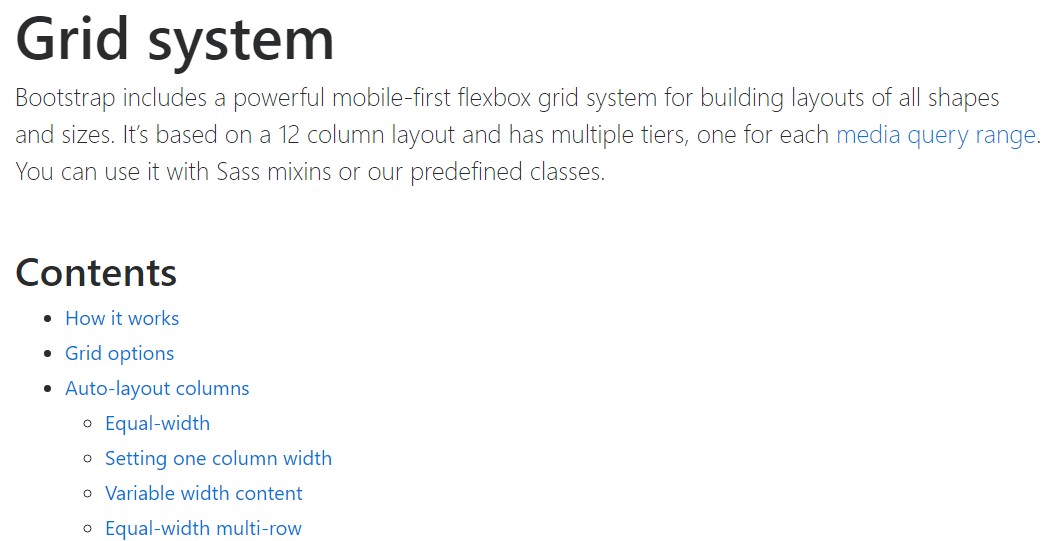
W3schools:Bootstrap grid training
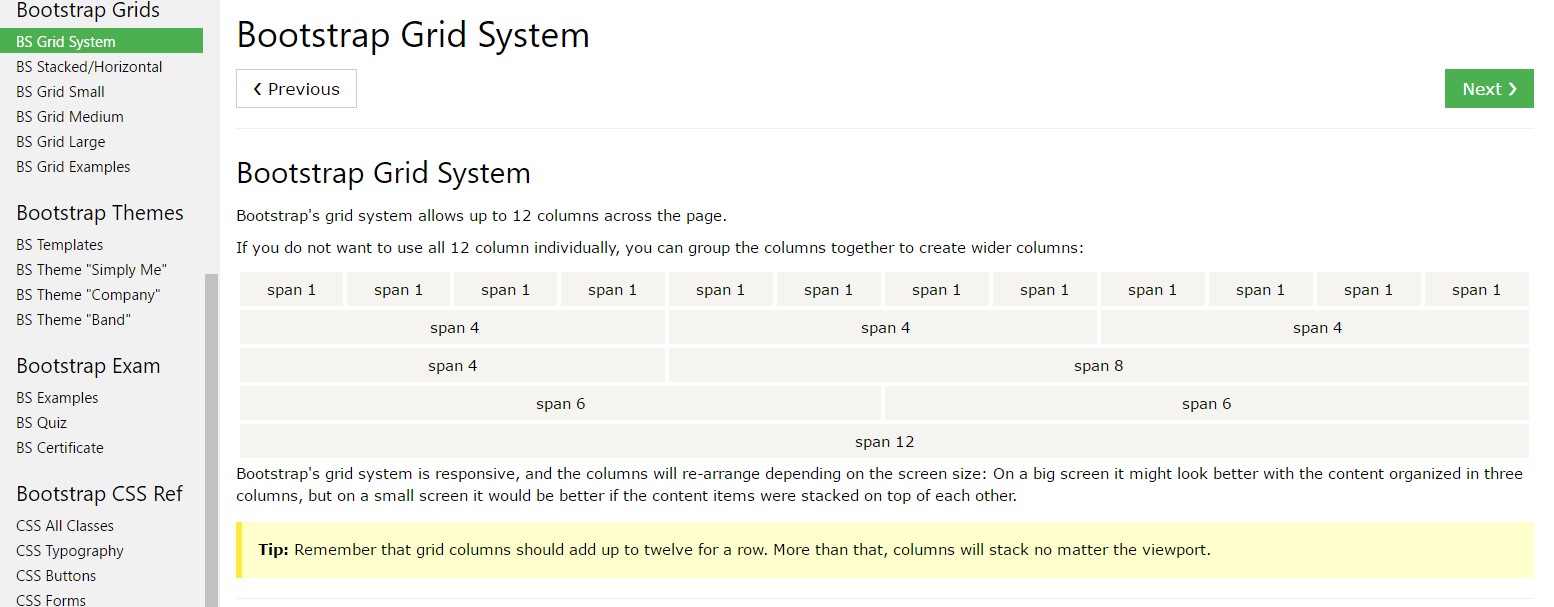
Bootstrap Grid column
